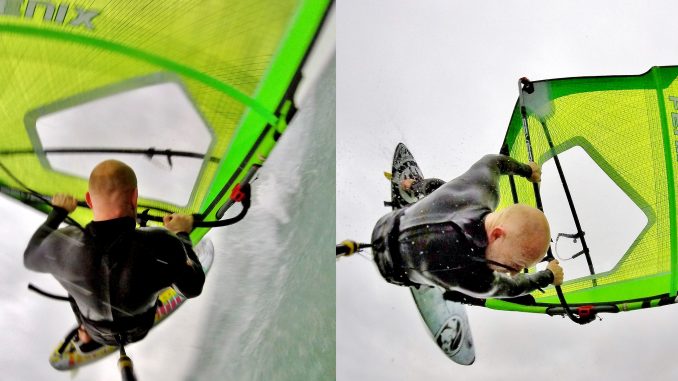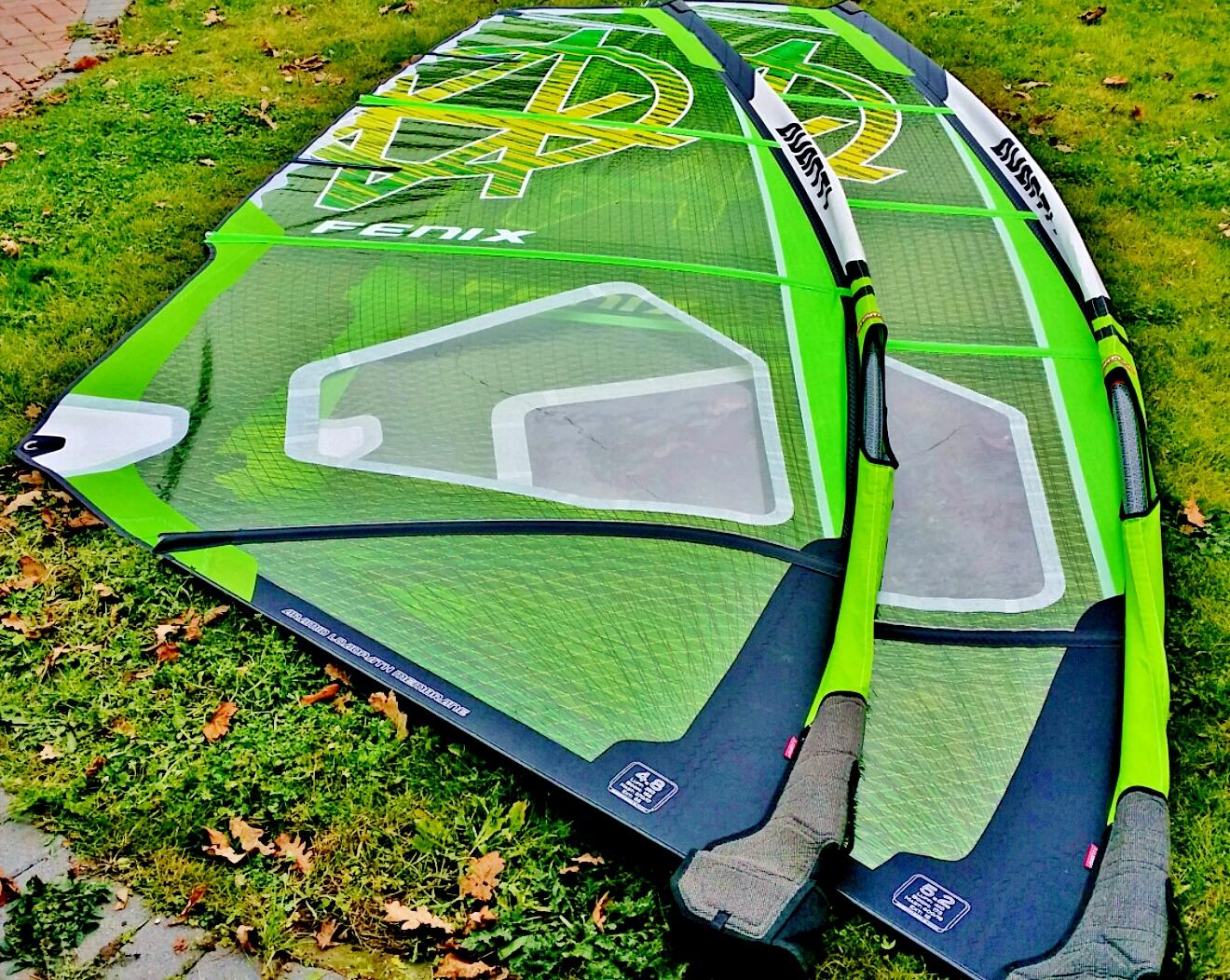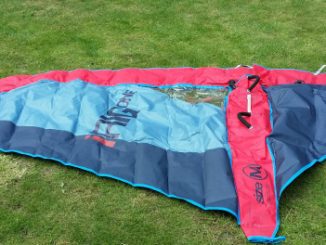
Words and pics: WSUK
![]() Having interviewed Dan Kaseler (Avanti Sails head honch and designer – see String Theory article here) prior to getting hold of the Fenix 5.2m we were intrigued by what we’d find. Coming in lime green livery the Fenix is certainly eye candy. Avanti’s distinct branding also adds to the mix.
Having interviewed Dan Kaseler (Avanti Sails head honch and designer – see String Theory article here) prior to getting hold of the Fenix 5.2m we were intrigued by what we’d find. Coming in lime green livery the Fenix is certainly eye candy. Avanti’s distinct branding also adds to the mix.
Avanti’s method of laying up sails (membrane technology) is immediately obvious. There had been a lot made about the weight of the Fenix prior to laying hands on. Once sheathed (on Avanti’s Spine 400 mast) lifting is a joy. OK, at this point no boom is attached, but 3.1g is impressive none-the-less. Avanti claim their sails are 15%-20% lighter than industry standards. While we didn’t get chance to compare the Fenix is definitely lightweight. Having affixed a boom there wasn’t much additional weight.
Unlike smaller size Fenix sails, which are four batten, Avanti’s 5,2m is a x5 affair. That said it’s still compact. There’s a lot of clearance below the boom with it’s cut in design. Added reinforcements – such as the Helix Leech Plys, a Teijin 8083 luff sleeve and anti-abrasion batten pockets – lend durability. Its Cobra Vision Window gives good visibility – even though it’s smaller than many – without sacrificing integrity. All in, there’s a huge amount of thought and technology running throughout Avanti’s Fenix 5.2m – getting it afloat was a tantalising prospect.
On the water
Due to the Fenix’s feather like nature you’d be forgiven for thinking there’s no low end power. Yet during sessions when the wind was squiffy we’d only have to pump a few times to get up and planning. Our 85kg rider weight required a little less downhaul and outhaul in gusty winds and lighter airs. Even though it’s five battens are plain to see the Fenix 5.2m does a good job of performing like a four batten. With increasing wind adding a touch of outhaul (firstly) flattened the profile but allowed what grunt there is to remain. Of course, sailors are free to add more tension but too much eradicates all rider feedback – some may like this, however.
A nice trait of the Fenix is it ‘breathing’ properly – riders can literally see this happening as the sail billows and flattens. Whether by design or accident the Fenix feels alive and subtle rider adjustments allows power to switch on and off at will. It has impressive range without becoming too much of a handful in blowy conditions. With stronger puff in the mix gusts do their best to pull riders off centre. The Fenix copes and remains composed – you can’t fault its manners.
Moves
The Fenix is designed primarily with waves in mind. And yet, for any coastal sailor, who dabbles in waves, bump and jump and possibly freestyle, Avanti’s Fenix 5.2m makes for a versatile ‘engine’, accommodating many different moods and scenarios.
If spinning into sliding freestyle moves the Fenix gives enough boost to pop but then depowers through the sail switch before powering back up (progressively) as riders require. The same performance benefits you’ll find when wave riding make it applicable for vulcans, spocks, grubbies and such like. Obviously there are more specialist tools in Avanti’s range for this discipline but it’s nice to know the Fenix accommodates.
When boosting backies and forwards the compact nature of the Fenix allows quick but controllable transitions. Its whip (when forward looping for instance) is exactly what you need for stylish pole vaults – especially those with less height.
For wave riding it’s a super-efficient sail. Probably at the top of purist wave sailor quivers, in terms of size, it’s fitting for float and ride – there being enough power to pull riders along and get onto open faces – but remaining composed and throw around when breeze picks up. If you’ve ever aspired to fully laid down bottom turns, pro level stylee, the light weight of the Fenix allows a dynamic, forwards and full rail position. Surf orientated riders, who rely less on rig power, will love it.
Conclusion
As windsurfers – particularly in the UK with ever changing conditions – we need tools that can cope with a variety of scenarios. For some this size will fit many different requirements. Happily Avanti Sail’s Fenix 5.2m is not only a bona fide wave rider/jumper, it’s also applicable for sliding freestyle, carving moves and bump and jump. If the wind decides to go on hiatus then attaching it to a windSUP will also yield fun results. Manufactured in exemplary fashion, with a new take on construction, the Fenix 5.2m is an eye candy piece of kit that will win favour with a wide audience.
Price:
Avanti Sails Fenix 5.2m 919 euro
Avanti Sails Spine 400 mast 619 euro
Info: www.avantisails.com/sails/fenix/#overview
Dan Kaseler comments:
My first job sail making was not glamorous. I basically swept up the floor and cut Dacron triangles for corner patches at the local Neil Pryde loft in Seattle, then later at the North and Shore lofts. I ended up eventually working for Rushwind and Hurricane. Nik Baker and Luke Hargreaves were the team riders and I had front row seats of Dave Russell and his team building extraordinary sails for the World Cup. In 2005 I moved over to Gaastra where I had a six year run as the head of the windsurf R&D. In boats I was competing on strung membranes and I became super interested in finding a way to port the technology over to windsurfing – essentially miniaturizing it and making it viable for mass production. It was super obvious that it was a superior approach to sail making. My first membrane was a one-off prototype for my home-made foiling Moth dinghy. It was so lightweight and durable, it was only a couple weeks later and I was straight into a 9.4m windsurf race sail. With Avanti all our sails are custom strung and laminated with CNC controlled gantry systems. The savings in weight and the ability to tailor stretch characteristics is a massive leap in material technology. Instead of cutting cloth off a roll we are literally custom making the skin of your sail to suit needs. For me this is night and day to the old paradigm.








Leave a Reply